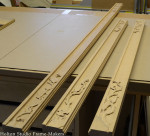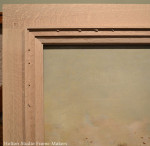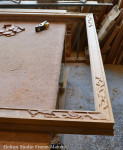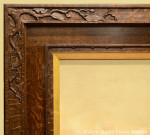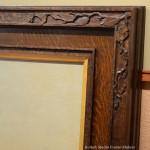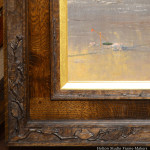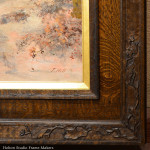We finished 2013 with a real flourish, completing the framing of this large (36″ x 60″) painting, “Figures on a Horse-Drawn Sledge with Fishers on a River” (no date) by Thomas Hill (1829-1908), one of California’s greatest early landscape painters—although this scene is believed to be New Hampshire. While all right labor, William Morris says, is “helping in the work of creation,” I count myself extraordinarily lucky to be asked to collaborate in a real sense, though across more than a century of time, with great painters like Hill and help in the presentation of their visions—and so, through the joiner’s art of framing, to join them to our own time and longings.
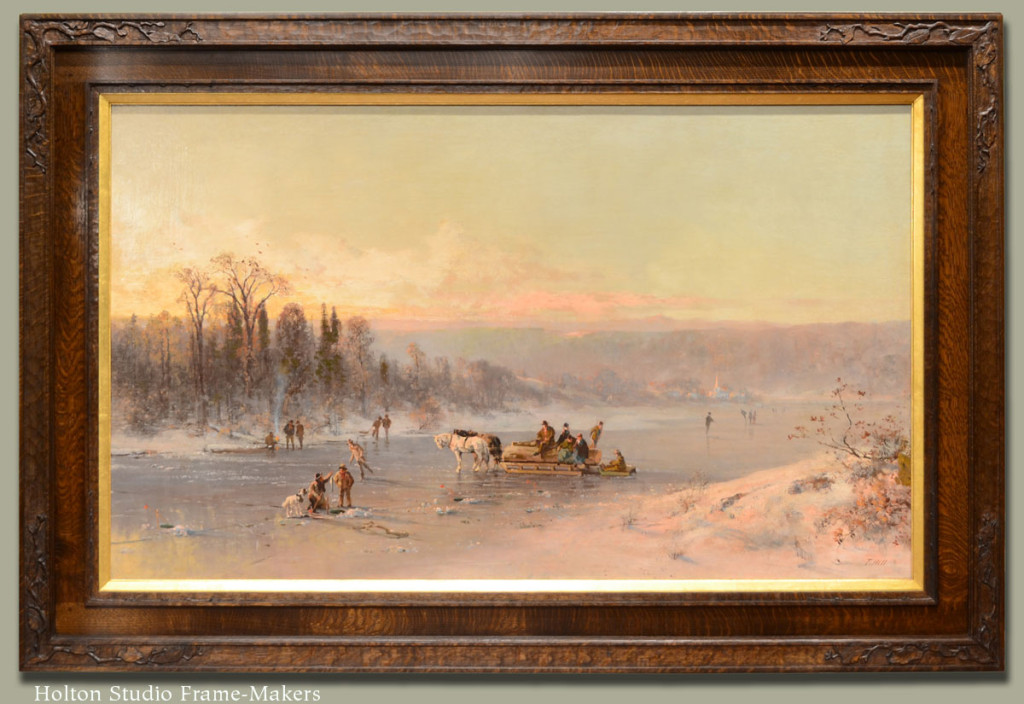
Thomas Hill (1829-1908), “Figures on a Horse-Drawn Sledge with Fishers on a River”. Click image for larger view. Detail and process shots at bottom of page.
The frame took far longer than it should have, in part because it came in a few weeks before my mother died and thus at the onset of yet another kind of winter. Its depiction of the survival of the human spirit through the winter therefore took on a deep and personal meaning for me — a picture I took to heart as profound and praiseworthy. I’ve been reading a lot of John Ruskin and William Morris, in preparation for a symposium on those two, and so hope you don’t mind—those many customers of mine who love the Arts and Crafts Movement might well be especially interested in it, in fact—an explanation in terms of some of the ideals of those two fathers of nineteenth century reform, artistic and social.
“All great art is praise,” as Ruskin told us, and that is among the first lessons of picture framing. The frame praises the picture, honors it, amplifies, sustains, carries out, articulates and proclaims its vision—but for all that, strictly as a subordinate accompaniment in obedience to Ruskin’s “law of help” (the first law of not only pictorial composition but the universe, Ruskin taught). So the frame is not pretentious glittering gold but rooted in the humbler, more directly architectural tradition of what are called in the trade cabinetmaker’s frames (even this little town likely has an ordinary cabinetmaker and woodcarver or two;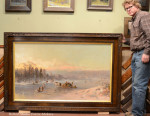 likely not, though, the more urbane type of frame shop producing gilded plaster-encrusted exhibition frames); and is dark (as are almost all my frames), in the shade and tone of the painting’s shadows so as to attract the eye, by contrast, not to itself but to the brighter painting. The frame is not in the spirit of exhibitionism that was typical of frames of Hill’s day, but is made in obedience to Morris’s ideal: “for beauty’s sake, and not for show.” The frame is quartersawn white oak—oaks not only populating the countryside of New Hampshire (those tall trees on the far shore may well be white oaks) but also having seen the human race through every winter we ever faced (see William Bryant Logan, Oak: The Frame of Civilization). The hand carving is my effort to sustain an art that most today regard as obsolete and irrelevant (“carvers are starvers,” is the old saying), and to work, as Morris urges, “like a good fellow trying by some dim candle-light to set our workshop ready against to-morrow’s daylight.” True to the teaching of Ruskin, the carving pattern (see detail shots below) is not conventional—or no more so than is suited to its place in the architecture of the frame—but drawn from life, depicting that phase when shrub branches sprout new leaves while the decaying old ones still cling to their support. And, being suggested by the dormant shrubs on the shore (far right), a subordinate and “framing” detail in the painting, the patterns are not arbitrary, as ornaments on frames so frequently are, but come from seeing the picture and the task of helping the viewer see it—seeing truly, of course, underpinning all of Ruskin’s thought. (More low relief naturalistic carving like this can be seen on my specialty mirrors…) The frame is made “to the picture,” wholly adapted and unique to it, alive to it, and meant to sustain its unique spirit into the architecture of the home and the daily life carried on there. So it is a prime example of my mission to help revive the debased and near-dead art form of picture framing, awaken it from its winter’s sleep, and restore its connection—and thus the connection of painting—to ordinary daily life, guiding that life with our most profound ideals, including that which so evidently moved Hill to paint this canvas: our “reverence for man’s life on the earth” (the sum, Morris said, of all he was trying to teach people).
likely not, though, the more urbane type of frame shop producing gilded plaster-encrusted exhibition frames); and is dark (as are almost all my frames), in the shade and tone of the painting’s shadows so as to attract the eye, by contrast, not to itself but to the brighter painting. The frame is not in the spirit of exhibitionism that was typical of frames of Hill’s day, but is made in obedience to Morris’s ideal: “for beauty’s sake, and not for show.” The frame is quartersawn white oak—oaks not only populating the countryside of New Hampshire (those tall trees on the far shore may well be white oaks) but also having seen the human race through every winter we ever faced (see William Bryant Logan, Oak: The Frame of Civilization). The hand carving is my effort to sustain an art that most today regard as obsolete and irrelevant (“carvers are starvers,” is the old saying), and to work, as Morris urges, “like a good fellow trying by some dim candle-light to set our workshop ready against to-morrow’s daylight.” True to the teaching of Ruskin, the carving pattern (see detail shots below) is not conventional—or no more so than is suited to its place in the architecture of the frame—but drawn from life, depicting that phase when shrub branches sprout new leaves while the decaying old ones still cling to their support. And, being suggested by the dormant shrubs on the shore (far right), a subordinate and “framing” detail in the painting, the patterns are not arbitrary, as ornaments on frames so frequently are, but come from seeing the picture and the task of helping the viewer see it—seeing truly, of course, underpinning all of Ruskin’s thought. (More low relief naturalistic carving like this can be seen on my specialty mirrors…) The frame is made “to the picture,” wholly adapted and unique to it, alive to it, and meant to sustain its unique spirit into the architecture of the home and the daily life carried on there. So it is a prime example of my mission to help revive the debased and near-dead art form of picture framing, awaken it from its winter’s sleep, and restore its connection—and thus the connection of painting—to ordinary daily life, guiding that life with our most profound ideals, including that which so evidently moved Hill to paint this canvas: our “reverence for man’s life on the earth” (the sum, Morris said, of all he was trying to teach people).
Who says paintings and the work of the hands aren’t a necessity? I have very much needed this painting and its reminder of the enduring powers of the human spirit. Winters will always come, and their harshness is indeed life-threatening, the light dim and somber in more ways than one. But through the astonishing powers of invention, imagination, adaptation and simply taking joy we humans have always had the strength and power to survive it. In the dark of winter let us not ignore “the light of the world” that is, Ruskin reminds us, the human spirit and brighter than the sun.
“Labor, and make harmony,” (to toss in one more quote from Ruskin) and please keep yourself warm in body and spirit!
More work by Thomas Hill is in the Portfolio, here and here (note the artist’s dog, eyeing the fish in this painting also depicted in the latter small fishing scenes).
More pictures—
- The carving roughed out
- The carving modeled
- Three sides done.
- The flat, inner molding and liner.
- Eric finishing up the cap molding


